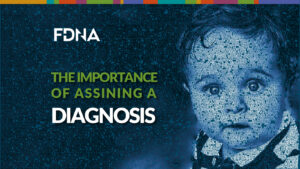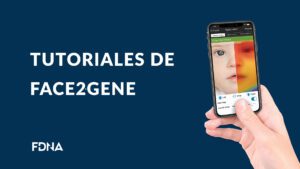The performance of FDNA’s facial analysis technology, Face2Gene, was recently put up to the challenge of recognizing facial features of children ages 2-6 with CHARGE syndrome compared to a control group of children with other syndromes. The results demonstrate that this technology successfully recognizes children with CHARGE syndrome with a high degree of accuracy (measured by the AUC of the ROC curve), for all age groups analyzed.
A big thanks to Prevention Genetics who sponsored the month of June in the FDNA Year of Discovery to advance understanding of eye disorders, as well as providing a charitable donation to support Bardet Biedl Syndrome Foundation for each case analyzed during the month.
CHARGE Syndrome
Coloboma of iris or retina
Heart defects
Atresia of the choanae
Retardation of growth and development
Genital anomalies
Ear abnormalities
The Study
The hypothesis: The facial analysis technology can successfully recognize facial features of children with CHARGE syndrome.
To test the performance of this technology, FDNA built a single syndrome classifier for CHARGE syndrome and assessed its effectiveness in recognizing its facial gestalt. This classifier was applied to people ages 2, 3, 5 and 6 years.
Two experiments were implemented.
1. Individuals with CHARGE Syndrome vs. Unaffected Individuals
To determine the discrimination abilities of this technology, 46 children with CHARGE syndrome, (17 age 2, 16 age 3, 16 age 5, and 13 age 6), were compared to individuals from an unaffected population (100 per age group). Classification success was measured by using the area under the curve (AUC) of the receiver operating characteristic (ROC) curve. An AUC of 100% represents perfect separation, and an AUC of 50% suggests random separation no better than the flip of a coin.
Comparing the features of young children with this genetic disorder to features of children from an unaffected population delivered results of a 92% AUC for ages 2 and 3, 93% for age 5, and 97% for age 6. The high performance across these age groups confirms that facial analysis is useful in recognizing CHARGE syndrome-related characters.
2. CHARGE Syndrome Individuals Vs. Other Syndrome Individuals
The same children with CHARGE syndrome were then compared to children with various syndromes ages 2, 3, 5, and 6 comprising 100 per age group. This analysis of children with CHARGE syndrome compared to subjects with other conditions resulted with a 66% AUC for age 2, 84% for age 3, 82% for age 5, and 92% for age 6. The high performance for older individuals indicates that facial analysis is helpful in distinguishing the difference between the facial gestalt of CHARGE syndrome and that of another. This data also emphasizes that individuals with this genetic disorder are better recognized at age 6 than at younger ages, which suggests that the facial phenotype becomes more distinct with age.
Data from the comparisons among the smaller age groups exposed shared facial characteristics between children with CHARGE syndrome and children with alternative conditions. These results denote that facial analysis is useful, but is presented with potential hindrances when considering multiple syndrome options in younger patient evaluations, making earlier diagnosis a more arduous task.
The syndrome classifier for CHARGE syndrome is available to all clinicians involved in patient evaluations via Face2Gene CLINIC.



